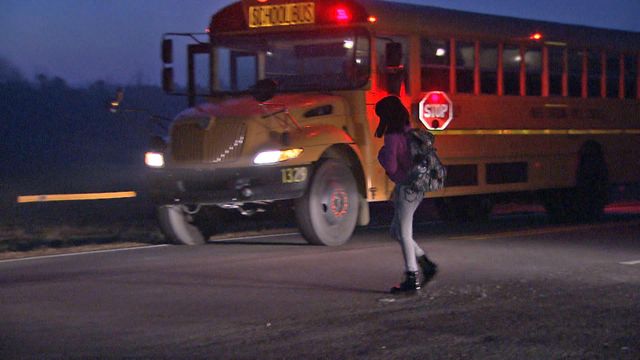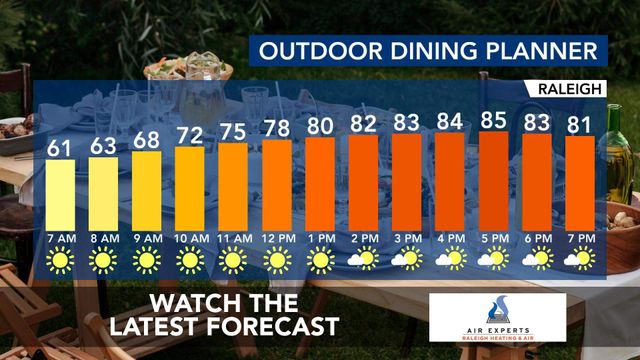'It's just dangerous': Wake parents share bus stop safety concerns
Even before the sun is up, tens of thousands of school kids catch their buses in Wake County, with many crossing busy roads to get on board.
In the past 15 years, North Carolina has had the third highest number of bus stop fatalities in the country, according to data WRAL News analyzed from a national loading and unloading survey from the Kansas State Department of Education.
Thirteen students have died, and an unknown number of students have been injured. The injuries are unknown because school systems don’t track those numbers. After WRAL’s 5 On Your Side asked about injuries, North Carolina Department of Public Instruction officials said they plan to start tracking it.
One of the major concerns parents say they have is where bus stops are located. It’s a big issue in Wake County, especially after thousands of stops were eliminated this school year. More than 10 parents contacted WRAL News with concerns about safety at their children’s bus stops, including early morning stops, high speed limits and busy roads.
“It’s just dangerous,” said parent Heather Holt, whose daughter Isabel must cross three lanes of traffic on Ray Road, where the speed limit is 45 mph, to get to her bus.
WRAL witnessed a student dart between two cars to get across Poole Road in the dark to catch an approaching bus. The speed limit is 55 mph.
Parent Nick Mullins waits with his fourth-grade son at the bus stop every day. He said the bus driver recommended it, even though parents with kindergartners and first-graders are the only ones required to be present.
“She asked us to come out every morning and make sure that we're with him when he has to cross the road, because you never know what's going to happen,” Mullins said.
For the Burgess family, something bad did happen.
“He was lying in the ditch, and he told me he didn’t want to die, and I assured him he wouldn’t. But … I still didn’t know,” said Michael Burgess Sr., whose son Michael Burgess Jr. was hit by a car as he crossed Johnson Pond Road in Fuquay-Varina while trying to get to his bus on Sept. 30, 2014.
Months later, his visible injuries are turning to scars and he’s in therapy for post-traumatic stress disorder. He can’t even look at other children at a bus stop.
"I couldn't watch people cross the road, because I thought a car wouldn't stop and I'd see somebody else got hit by a car,” Michael Burgess Jr. said.
Burgess’ bus stop used to be on a quiet neighborhood road. The family says the school system moved it due to safety concerns. Then, it was moved to a much busier Johnson Pond Road and deemed safe.
Other parents complained about similar changes with bus stops after budget cuts led the Wake County Public School System to eliminate 4,000 stops this school year.
“It angers me to save a few cents on fuel to make a child cross the road,” said Michael Burgess Sr. “It shouldn't be that way.”
Wake County public schools’ leaders admitted they've received hundreds of complaints from parents about the safety of bus stops this school year. After the school system investigated, Chief Business Officer David Neter said more than 90 percent of those complaints were not valid.
So, how is bus stop safety assessed? How are bus routes, stops and times decided? And what does the school system do with parents’ safety concerns? Wake school leaders declined to do an interview with WRAL News, giving several reasons. Among them, they said talking about bus routes, stops and times violates a federal law that protects student education records.
WRAL News filed a public records request to get copies of parent requests and related correspondence from the school system for school bus stop changes that were granted during the current school year, but the school system declined to release the records.
“The reason WCPSS cannot provide you the requested records is that they are ‘education records’ of individual students protected as confidential under the Family Education Rights and Privacy Act (FERPA),” Wake schools’ attorney Neal Ramee said in an emailed statement. “Providing you the requested records would violate this federal law.”
WRAL News explained that no students’ or parents’ names were being sought as part of the public records request, but Wake schools still declined to release the records.
Wake County public schools is one of many North Carolina school districts that use the Transportation Information Management System, also known as TIMS. It's like a GPS system that uses student addresses to map bus routes. The head of transportation at North Carolina's Department of Public Instruction explained the overall concept.
"We started out with TIMS for basically the perspective of efficiency, to give school districts a tool,” said Derek Graham, DPI’s section chief of transportation services, adding that it is more cost effective. “Once they knew where the kids lived and what school they were going to, to try to do that as efficient way as possible.”
As for how specific stops are designated, Graham says that’s more of a school district role, adding that “the local superintendent is ultimately responsible for the location of school bus stops.”
"Ideally, every school bus stop would be what we call a door-side pickup, but the realities of that make it pretty much impractical,” Graham said.
Wake County public schools' website says the system considers everything from lighting to pathways to traffic volume and speed in placing stops.
Another complaint WRAL News heard from parents was how long the school system takes to assess requests to move bus stops. Holt said her request to move her daughter's stop back into the neighborhood took months.
"So, five months total to finally get their answer that they determined that it was more dangerous to have the bus go into the neighborhood which, again, they've done for five years with no issue before,” she said. "It only takes one time, and we've seen it more than once, for a speeding car trying to beat the stop, to pass while the children are crossing.”
Nothing has changed at Burgess' stop either. The children in his neighborhood still have to cross the road every morning.
So, what's the fix? It's a dilemma for Wake County public schools, which eliminated bus stops after budget cuts were approved by the North Carolina General Assembly. While schools have a responsibility to keep students safe, drivers have to pay attention, too.
Estimates show 3,000 drivers illegally pass stopped school busses each day in North Carolina, according to NCBusSafety.org.
Students also have to be aware of their surroundings. WRAL News saw a high-schooler wearing ear buds and a hoodie get off a bus and cross the street. A nearby driver never stopped and zipped right by him. The driver appeared to be oblivious and didn't notice the bus driver lay on the horn.











